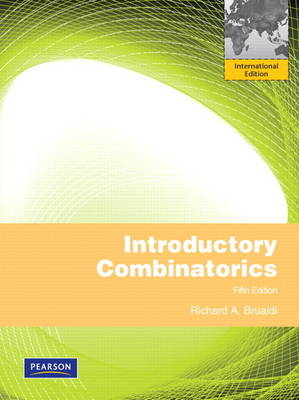
Introductory Combinatorics
Pearson (Verlag)
978-0-13-279171-7 (ISBN)
- Titel ist leider vergriffen;
keine Neuauflage - Artikel merken
This trusted best-seller covers the key combinatorial ideas—including the pigeon-hole principle, counting techniques, permutations and combinations, Pólya counting, binomial coefficients, inclusion-exclusion principle, generating functions and recurrence relations, combinatortial structures (matchings, designs, graphs), and flows in networks. The Fifth Edition incorporates feedback from users to the exposition throughout and adds a wealth of new exercises.
Richard A. Brualdi is Bascom Professor of Mathematics, Emeritus at the University of Wisconsin-Madison. He served as Chair of the Department of Mathematics from 1993-1999. His research interests lie in matrix theory and combinatorics/graph theory. Professor Brualdi is the author or co-author of six books, and has published extensively. He is one of the editors-in-chief of the journal "Linear Algebra and its Applications" and of the journal "Electronic Journal of Combinatorics." He is a member of the American Mathematical Society, the Mathematical Association of America, the International Linear Algebra Society, and the Institute for Combinatorics and its Applications. He is also a Fellow of the Society for Industrial and Applied Mathematics.
1. What is Combinatorics?
1.1 Example: Perfect Covers of Chessboards
1.2 Example: Magic Squares
1.3 Example: The Four-Color Problem
1.4 Example: The Problem of the 36 Officers
1.5 Example: Shortest-Route Problem
1.6 Example: Mutually Overlapping Circles
1.7 Example: The Game of Nim
2. The Pigeonhole Principle
2.1 Pigeonhole Principle: Simple Form
2.2 Pigeonhole Principle: Strong Form
2.3 A Theorem of Ramsay
3. Permutations and Combinations
3.1 Four Basic Counting Principles
3.2 Permutations of Sets
3.3 Combinations of Sets
3.4 Permutations of Multisets
3.5 Combinations of Multisets
3.6 Finite Probability
4. Generating Permutations and Combinations
4.1 Generating Permutations
4.2 Inversions in Permutations
4.3 Generating Combinations
4.4 Generating r-Combinations
4.5 Partial Orders and Equivalence Relations
5. The Binomial Coefficients
5.1 Pascal's Formula
5.2 The Binomial Theorem
5.3 Unimodality of Binomial Coefficients
5.4 The Multinomial Theorem
5.5 Newton's Binomial Theorem
5.6 More on Partially Ordered Sets
6. The Inclusion-Exclusion Principle and Applications
6.1 The Inclusion-Exclusion Principle
6.2 Combinations with Repetition
6.3 Derangements
6.4 Permutations with Forbidden Positions
6.5 Another Forbidden Position Problem
6.6 Möbius Inversion
7. Recurrence Relations and Generating Functions
7.1 Some Number Sequences
7.2 Generating Functions
7.3 Exponential Generating Functions
7.4 Solving Linear Homogeneous Recurrence Relations
7.5 Nonhomogeneous Recurrence Relations
7.6 A Geometry Example
8. Special Counting Sequences
8.1 Catalan Numbers
8.2 Difference Sequences and Stirling Numbers
8.3 Partition Numbers
8.4 A Geometric Problem
8.5 Lattice Paths and Schröder Numbers
9. Systems of Distinct Representatives
9.1 General Problem Formulation
9.2 Existence of SDRs
9.3 Stable Marriages
10. Combinatorial Designs
10.1 Modular Arithmetic
10.2 Block Designs
10.3 Steiner Triple Systems
10.4 Latin Squares
11. Introduction to Graph Theory
11.1 Basic Properties
11.2 Eulerian Trails
11.3 Hamilton Paths and Cycles
11.4 Bipartite Multigraphs
11.5 Trees
11.6 The Shannon Switching Game
11.7 More on Trees
12. More on Graph Theory
12.1 Chromatic Number
12.2 Plane and Planar Graphs
12.3 A 5-color Theorem
12.4 Independence Number and Clique Number
12.5 Matching Number
12.6 Connectivity
13. Digraphs and Networks
13.1 Digraphs
13.2 Networks
13.3 Matching in Bipartite Graphs Revisited
14. Pólya Counting
14.1 Permutation and Symmetry Groups
14.2 Burnside's Theorem
14.3 Pólya's Counting formula
| Erscheint lt. Verlag | 19.5.2011 |
|---|---|
| Sprache | englisch |
| Maße | 180 x 235 mm |
| Gewicht | 778 g |
| Themenwelt | Mathematik / Informatik ► Mathematik ► Graphentheorie |
| ISBN-10 | 0-13-279171-4 / 0132791714 |
| ISBN-13 | 978-0-13-279171-7 / 9780132791717 |
| Zustand | Neuware |
| Haben Sie eine Frage zum Produkt? |
aus dem Bereich
